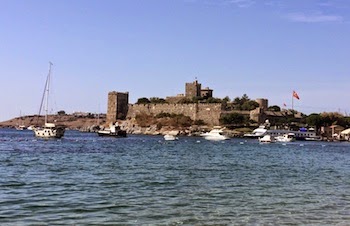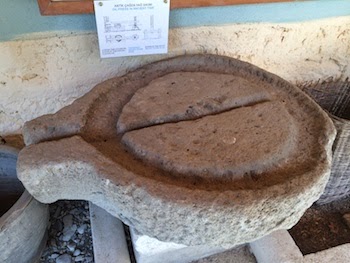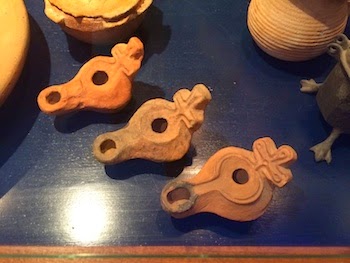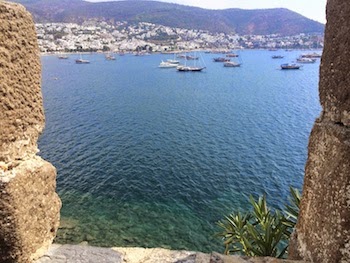 |
| Bodrum’s Crusader Castle |
Bodrum, in ancient times, was known as Halicarnassus. If this rings a bell for you, we’ll remind you why in tomorrow’s blog. Whatever you call it, Bodrum’s been an important city for quite some time. In the middle of the two crescents of shoreline that make up Bodrum, standing watch over the Aegean sea, is a castle. Its name is ambiguous: we’ve seen it written Crusader’s Castle, Saint Peter’s Castle, and (simply put) Bodrum Castle. The day after we returned from our Blue Cruise, we visited the castle.
Anytime you visit a city with a castle, it’s likely the castle is going to be a principle attraction. But stuffed into the nooks and crannies of Saint Peter’s Crusader’s Castle of Bodrum is Turkey’s Underwater Archaeology Museum, a repository for all the interesting things men have pulled up from the Aegean and Mediterranean waters that make up Turkey’s coast. Once upon a time, Lori and I were divers (that is scuba divers, though we prefer the 60’s term “frogmen”), so seeing stuff already pulled up out of the water seemed to save a lot of time and expense in gearing up and finding a dive shop. The two-for-one castle and underwater archaeology museum was right up our alley.
First, a quick history of this remarkably well-preserved castle. It was constructed, unsurprisingly (given one of its names) by crusaders, specifically the Knights of Saint John1, who thought it a great R&R spot on their way to and from the Holy Land. Having spent a week cruising these waters, we think they were probably right. It was built in the 1400’s on top of an earlier Byzantine castle, which might be where the name Saint Peter’s Castle came from. Towers were added from time to time as bands of crusaders passed through, eventually leading to a total of five. In the “English Tower” there are 249 coats of arms of various knights who did time at this castle during one or more crusades. The castle typically could accommodate about 200 soldiers and knights.
In early 1523, the Turks captured the island of Rhodes, just a few miles southwest of modern Bodrum. With the tide turning against them, the Knights of Saint John wisely abandoned the castle and the surrounding area to the Turks. For the next few hundred years, the castle was of little importance given the Ottoman empire’s size and control of the eastern Mediterranean. And then, during World War I, the castle saw its most recent action when it was bombed by the French (recall that the Ottoman Empire was allied with Germany during WWI). In the 1960’s, people starting storing those underwater artifacts here, and it became a museum in 1964. It is the world’s largest collection of artifacts retrieved by underwater archaeologists.
 |
| Amphora Collection |
As might be expected, the museum has a huge collection of amphora: clay jars that men have used to store and transport (often by boat) wine and olive oil from ancient to modern times. They come in all shapes and sizes, with pointed, rounded, and flat bottoms, depending on how they were stored, stacked, and transported. The museum does a great job of showing them in chronological order, with examples of both the mundane and exquisite varieties. There are so many of these vessels here that, by our calculation, removing them all from the Mediterranean lowered the sea level by ten feet. Ok, that’s an exaggeration, but you get the idea.
Also among the collection is enough statuary for us to wonder if the lost city of Atlantis was actually squirreled away in this castle; stone olive presses that made us wonder if olive oil had been made at sea while in transit, or whether an ancient olive press manufacturer’s ship had sunk in transit somewhere; tidbits from numerous shipwrecks, including some tiny, delicate, clay oil lamps bearing Christian motifs; and beautiful early (1st and 2nd century) glass vases.
 |
| 1st Century Olive Oil Press Olives go in the groove & two wheels on an axle smash the oil out of them |
 |
| Delicate Clay Oil Lamps Retrieved from a Shipwreck |
 |
| 1st Century AD Glass Vases |
Under centuries of Ottoman use, the castle naturally took on a Turkish flare, including the conversion of the chapel to a mosque and the addition of a minaret. The castle is large and rambling, enough so to incorporate some nice little gardens. There’s also the dungeon: surprisingly small for a castle this large, and not really worth the effort of climbing down steep stairs (and then back up) to see. The best feature of the castle, we’re sure everyone agrees, are the views.
 |
| Castle Minaret |
 |
| Harbor View from the Castle |
Notes
1 Saint John, the author of the book of Revelation, received his visions on the island of Patmos, which happens to be just off the coast of Turkey, a ferry ride away from Bodrum. Patmos was one of the excursion options we could have taken while in Bodrum. Ephesus–where Saint Paul’s Ephesians lived–was another option.






